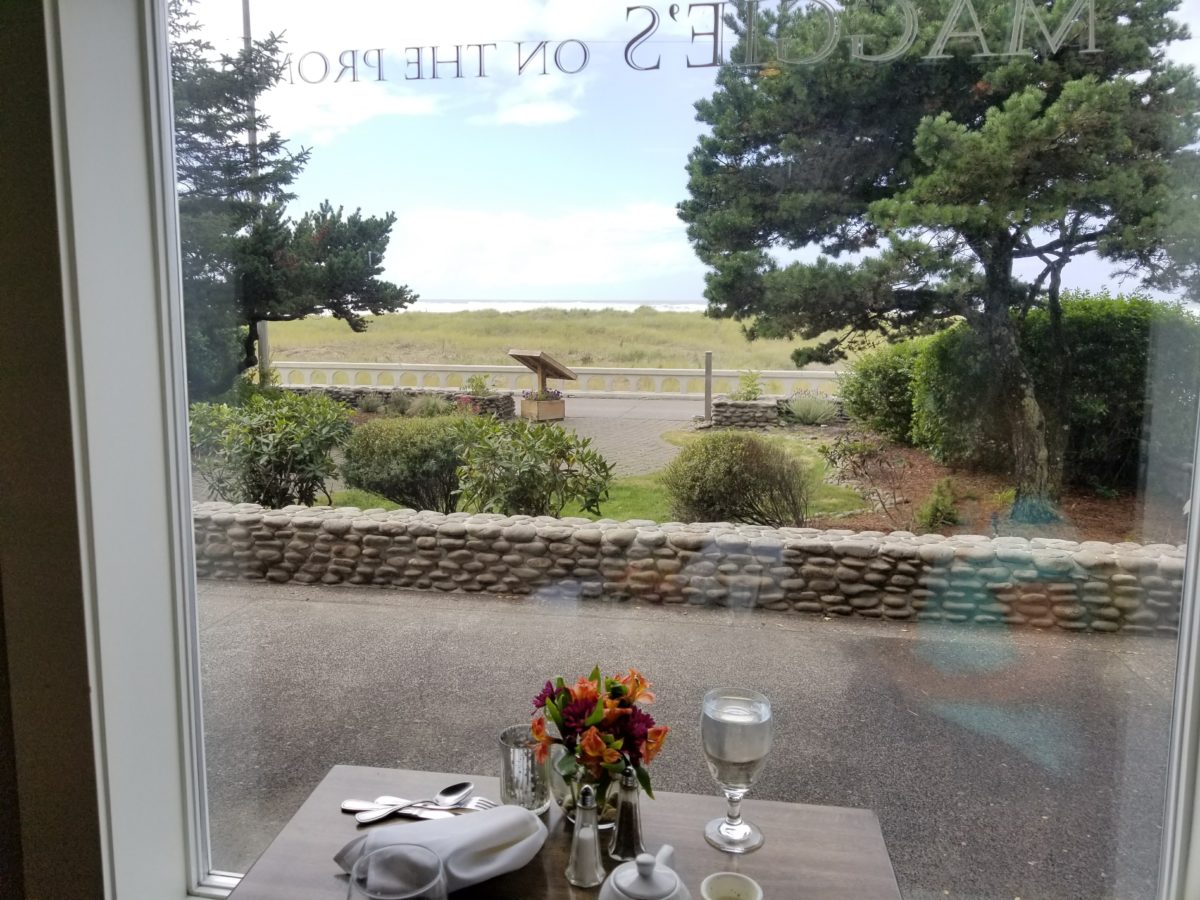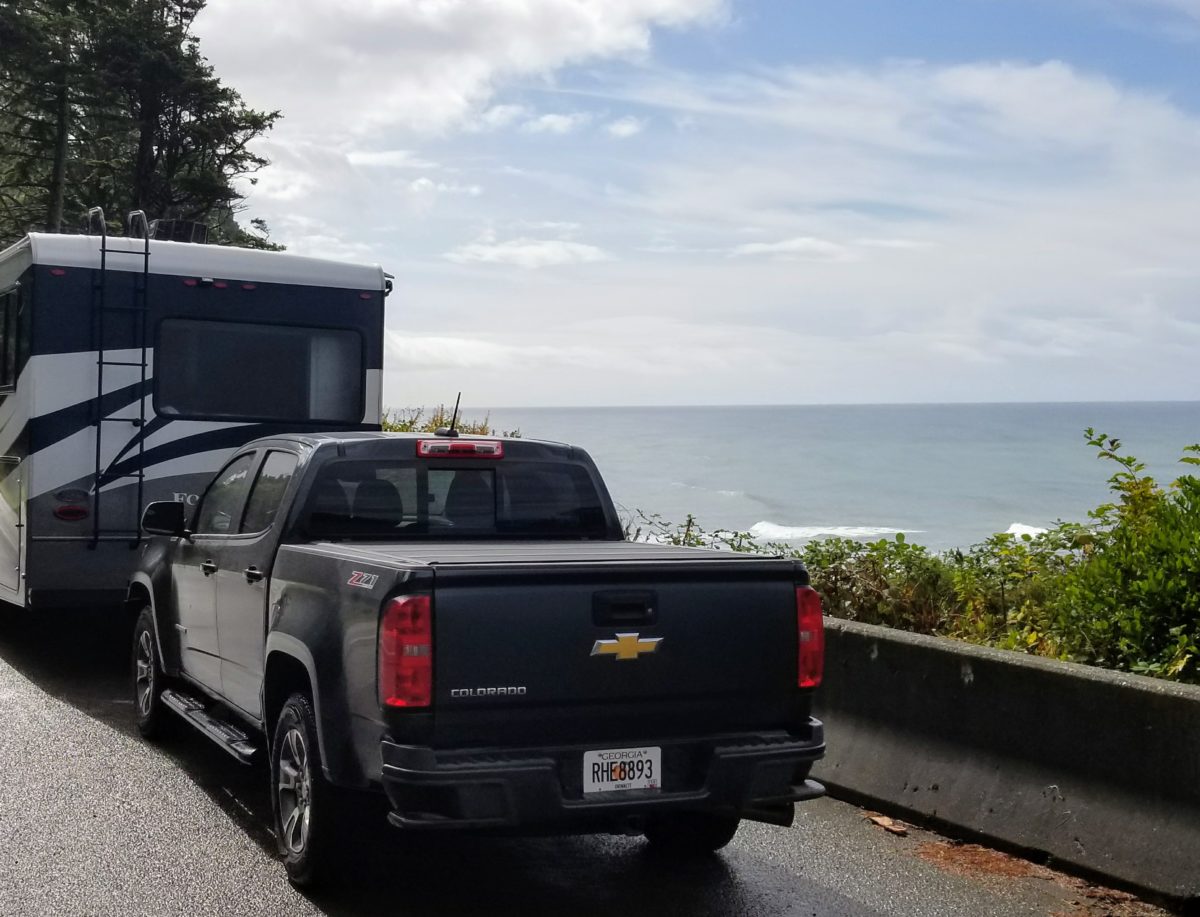With having to deal with the closed interstate and the bridge and mirror, we arrive at Emigrant Springs State Park after dark. It’s 35 degrees, according to my phone, in the closest town, Meacham, Oregon. It’s heading down into the twenties in a few hours.
We stop at the vacant gate house to unhook the truck and to try to see where the campsites are. I don’t know how they even knew we were there, but two women appeared in a golf cart and asked if we needed help. Yes, we did, thank you. They were the campground hosts. One of them got out so Jane could ride in the cart while the host showed Jane the available sites. Mike and I chatted with the other woman. They were sisters, 18 years apart in age and best buds.
When Jane and the host returned, they reported that the only sites available were tent sites — no hookups. The host said, “You can use a generator at night if there is a medical reason.” We did need to run a CPAP, but didn’t want to bother people and listen to the generator all night ourselves if we didn’t have to. We have a small inverter for this kind of situation. (For non-RV’ers, the coach has large 12 volt batteries to power lights, water pump, and a number of other things, but 120 volt equipment does not work unless you are connected to “shore power.”) This is the first time we have camped without a power hookup.
Our very kind and friendly hosts asks Jane about firewood. Jane loves a fire so she immediately orders some. Our campground hosts were the two sisters and Richard, who I assume was the husband of one of them. The three of them live in a fifth wheel trailer. By the time we get the RV to the campsite, Richard has already delivered the firewood to our site. Great service.
We don’t have a campfire tonight. Tired and hungry, we fire up the propane furnace. Jane has precooked spaghetti in the refrigerator (which runs on propane when not hooked up to 120 power) which she heats in the gas oven. We enjoy the meal and long, unhurried conversation, then make up the bed over the cab for Mike and retire for the night.
It’s morning and that generator now has to go to work. We need 120 volts for the coffee pot. Mike must like the cab-over bed. The sound of the generator cranking up doesn’t cause the slightest stir.
After breakfast, Richard, the campground host, knocks on our door. He says the site across the road is open. It has full hookups. He asks if we want him to move the firewood. I’m thinking that would be great, how kind to ask, but certainly we can do that ourselves since he has already delivered it once.

Over pancakes, Mike tells us a story about the nearby town of Pendleton. We wouldn’t mind just hanging around the park, but the story is so bizarre, we agree to drive into Pendleton. We would not have guessed that in Pendleton, Oregon, you can tour a once-secret underground, with restaurants, bars, brothels and opium houses! Mike explained that the Chinese laborers building the railroad could not be on the street at night, so they built their own city underground. We call to check on the tour and are disappointed to find that today’s tour is sold out. We decide to spend the afternoon exploring the park on foot.
Long before there were any settlements or railroads in this part of the world, Emigrant Springs became an important stop for the westward emigrants. A park interpretive sign explains: “It is a campground today, just as it was for Oregon Trail emigrants. Long before that emigration, Native Americans also took advantage of this site’s abundant waters and found shelter among the towering trees. Relations between emigrants and the Indians were generally positive in the Blue Mountains.”



“In the first week of January, 1812, a party of trappers and traders, members of the Astor Overland Expedition, crossed the Blue Mountains in this area. Traveling on foot in bitter cold, often waist deep in snow, they were the first white men in this area. The route they traveled between St. Louis and Astoria [on the Oregon Pacific coast] developed into the emigrant route to the Oregon Country, later to be known as the Oregon Trail. Wagon trains, Oregon bound, started their journey with the “greening” of the grass on the prairies, and crossed the “Blues” after completing some 2,200 miles of their journey, from late August to early October. Then, as now, this was the first forested area on the route.” From park sign.







Our new campsite is next door to the host’s site. They have a campfire burning all day. I think the firewood operation is their own business, and they have plenty of wood. Even though it is the middle of the day, the hosts are out warming themselves by a cheerful fire. I wonder over to start a conversation. I accuse them of moving us next door to them for the same reason my 4th grade teacher would move me up to the first row — to keep an eye on me. They stay here for four months every year, June-September. Next week, they will relocate to the camp in Arizona where they live the other eight months. I ask about new hosts. They will be no more hosts until they come back in June. The park will close next week for the winter, but the heated bathhouse will remain available for those using the hiking and horse trails in day use part of the park.
I was curious, why was the hood of their truck propped up with a piece of wood? I had seen a number of trucks with the hood propped up like this and couldn’t figure out why.

“Pack rats. They love to climb up and chew on the hoses, fan belts, and insulation. But they don’t like it with the hood open. They also don’t like those rope lights on the ground we put around the trailer. They won’t cross it. We took one of those darn things back to Arizona with us last year in the basement.”
I don’t know if that’s knowledge gained from scientific research or mythical knowledge passed on from RV’ers who have come before. Anyway, it’s knowledge that has been passed on to me and I’m passing it on to you.
The conversation turned to black tanks and toilet paper. I don’t know how; these things just happen with RV’ers. I told about our incident where we accidentally hooked up the water supply up to the black tank clean-out valve. They allowed they had done that, too, but didn’t notice it until water came up out of the toilet. Then they told me about their new black tank and how much it cost. The old one cracked. Naturally, I wanted to know exactly what happened when they discovered this.
One of the sisters also instructed me that I didn’t have to buy that expensive RV/Marine toilet paper, that any toilet paper labeled septic safe was fine. To test this, you put some of the paper in a jar of water see how well it disintegrates. She got up, went into her RV and came out with a roll of paper to give me. When I got back to our site, Jane wanted to know why I was carrying a roll of toilet paper.
Adventurer Richard Branson offered this advice to fellow thrill seekers: “If you’re embarking around the world in a hot air balloon, don’t forget the toilet paper. Once, we had to wait for incoming faxes.”
The sun is getting low. It’s cold; it’s time for us to make a fire.



It’s heading down to 28 degrees tonight. Rob got the soles of his boots smoking trying to get his toes warmed up in the fire.


They say good things must come to an end. We had thought that Mike would be riding with us to Boise tomorrow and he would fly back to Portland from there. But he found a flight out of Pendleton. I was amazed you could get a commercial flight out of Pendleton to Portland. The airport, the Eastern Oregon Regional Airport, is served by one airline, Boutique Air, which is subsidized by the Essential Air Service program of the U.S. Department of Transportation. Pendleton has some mining businesses; the Pendleton Roundup, a huge festival and rodeo once week a year; and the headquarters of the Confederated Tribes of the Umatilla Indian Reservation is in nearby Mission. I read the Confederated Umatilla Journal, and it appears that the Tribe has every government department that a state government would have. These government officials likely provide some business for the airport.
We need to leave the camp in the truck at 5:15 a.m. tomorrow to get Mike to the airport for his 6:45 a.m. flight. Mike says it won’t take long to get through security there, and it’s a 20 minute drive.
Lifelong memories can’t be scheduled. They just happen when they’re supposed to.
Quoted in Reader’s Digest.




















































